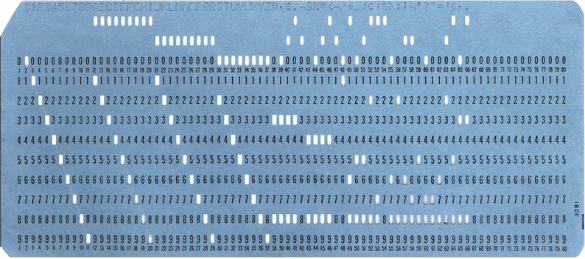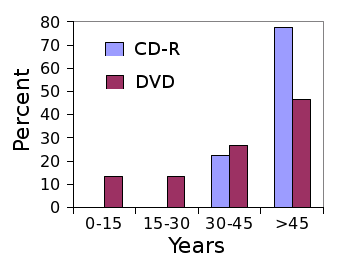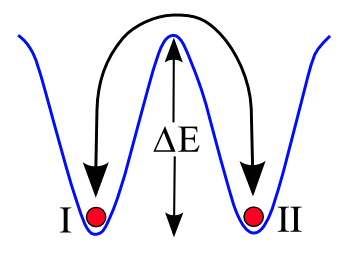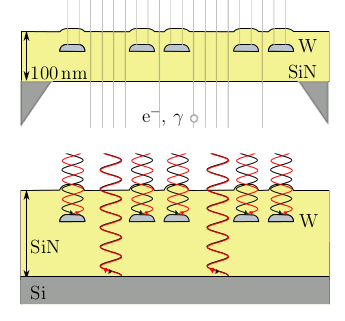Gigayear Data Storage
November 25, 2013
If your
office is similar to my office, you have stacks of
digital media that are not readable on your present
computer. There's the stray
3-1/2-inch floppy diskette, perhaps some
5-1/4-inch floppy disks, and a few
ZIP disks, on my shelves. There are some
eight-inch disks stored in a box, somewhere, for
historical purposes. I have several
nine-track tapes that I use as
show-and-tell items (I have a box of
vacuum tubes for the same purpose). My
data backups are on
CDs and
DVDs, and my desktop computer has an
optical drive to read these.
Most computers don't have an optical drive, since data storage is expected to be on
USB flash drives,
SD cards, or the "
cloud."[1] I object to
cloud computing, since I don't want to relinquish the safety of my data to another party. No matter what media are used, we always have the expectation that careful storage will allow our data to be read at any future time, provided we have a physical reader.

Eighty column punch-cards were once so common that artisans would make Christmas wreaths and Easter flowers from them. (Via Wikimedia Commons.)
I don't have any
punched cards on my shelves, but it's likely the data on those will be readable long after my present media can't be read. According to the
US National Institute of Standards and Technology (NIST), a DVD will retain your data less than fifteen years as a worst case, although
CD-R media have about double the life expectancy (see graph).[2]

Optical media lifetime, as determined by NIST.
CD-R is more archival than DVDs (all types).
(Graph rendered by author from data in ref. 1 using Gnumeric.)[1)]
Most
data centers of the later
20th century stored
archives on
reel-reel magnetic tape, since these have a very low
per bit cost, and they were expected to be readable after 15-30 years.[3] Cautious
system administrators would re-record data (transcribe) onto other reels every 5-10 years. Floppy disks and diskettes, although also
magnetic, will have a shorter lifetime, since rubbing
erodes the media. Today, magnetic tape storage in on
tape cassettes.
Such studies on media longevity have been done by
accelerated-aging experiments, which use a
first-principles model of how long data will remain in a media system. A memory
material will have an
energy barrier between its two data states (logical "0" and logical "1"), as shown in the figure. For such a system, an
Arrhenius law model can be used, and such a model has been applied to model the longevity of
magnetic media.[4]

Material stability modeled as an energy barrier ΔE between two states,
I and II.
(Illustration by by author using Gnumeric.)[1)]
According to an Arrhenius law model, data is corrupted by
thermal fluctuations that
randomly push a bit from its intended state to its
complement. The probability P for this to occur is an
exponential function of
temperature; viz.,
P = 1 - exp (-t/τ(T)
where
τ(T) = (1/f0) exp (ΔE/(kBT)
In these
equations,
τ is the decay time,
kB is the
Boltzmann constant,
T is the
absolute temperature, and
f0 is the attempt
frequency. The attempt frequency can be estimated as the
atomic vibration frequency, which can be as large as 10
13 Hz. These equations allow a calculation of what the energy barrier must be for a desired media lifetime. Allowing for
error correction, a million year memory needs an energy barrier of 63 k
BT. Boosting the barrier just a little, to 70 k
BT (1.8
eV at
room temperature), gives you a billion year memory.[5]
Scientists from the
University of Twente (The Netherlands), the
University of Freiburg (Germany) and
KIST-Europe (Saarbrücken, Germany) have published a proposal for a billion year memory on
arXiv.[5-6] It consists of a physical
pattern of one material embedded in another, and they demonstrated such a memory with
tungsten embedded in
silicon nitride (
Si3N4) (see figure). While using the Arrhenius law model, The authors caution against "
black swan" events, such as "
theft,
meteor impact or the
sun entering the
red giant phase."[5]

The tungsten-silicon nitride billion year memory.
There are two possible architectures; transparent, so it can be read by imaging with electron or photon beams, and another that uses interference effects.
(Figs. 3 and 4 of ref. 5, via arXiv.[5]
The experimental memory consisted of 100
nanometer tungsten lines embedded in silicon nitride. Tungsten was chosen because of its high
melting point (3422 °C) and low
thermal expansion (4.5 x 10
-6/K). Silicon nitride was chosen not only for its low thermal expansion (3.3 x 10
-6/K), but its high
fracture toughness and transparency to light; and, in a thin slab, its transparency to electrons. These two materials are commonly used in
microfabrication, so fabrication processes are well developed.[5-6]
According to the Arrhenius law model, a million year memory of this type, stored at room temperature, would need to survive for an hour at 445
kelvin (172 ° C). The memory survived this temperature, but there was significant information loss at 848 kelvin (575 ° C). The high temperature test was not really an appropriate aging test, since the thermal expansion difference between tungsten and silicon nitride caused cracks to appear.[5-6]
References:
- Technical people don't usually read poetry, but how can one not admire this verse from Shelley's poem, The Cloud:
That orb'ed maiden with white fire laden,
Whom mortals call the moon,
Glides glimmering o'er my fleece-like floor,
By the midnight breezes strewn;
Percy Bysshe Shelley, "The Cloud," from English Poetry II: From Collins to Fitzgerald, (The Harvard Classics, 1909–14, via Bartleby.com).
- NIST/Library of Congress, Optical Disc Longevity Study, September 2007 (PDF File).
- John W. C. Van Bogart (National Media Lab), "Mag Tape Life Expectancy 10-30 years," Letter to the editor of the Scientific American, March 13, 1995.
- S. H. Charap, P. L. Lu, and Y. He, "Thermal stability of recorded information at high densities," IEEE Trans. Magn., vol. 33, no. 1 (January, 1997), pp.978-983.
- Jeroen de Vries, Dimitri Schellenberg, Leon Abelmann, Andreas Manz and Miko Elwenspoek, "Towards Gigayear Storage Using a Silicon-Nitride/Tungsten Based Medium," arXiv Preprint Server, October 9, 2013.
- Million-Year Data Storage Disk Unveiled, Technology Review, October 21, 2013.
Permanent Link to this article
Linked Keywords: Office; digital media; desktop computer; 3-1/2-inch floppy diskette; 5-1/4-inch floppy disk; ZIP disk; eight-inch disk; historical; nine-track tape; show-and-tell; vacuum tube; data backup; compact disc; CD; DVD; optical disc drive; USB flash drive; SD card; cloud; cloud computing; punched card; punch-card; artisan; Christmas wreath; Easter; flower; Wikimedia Commons; US National Institute of Standards and Technology; CD-R; Gnumeric; data center; 20th century; archive; magnetic tape data storage; reel-reel magnetic tape; memory storage density; per bit cost; system administrator; magnetic storage; erosion; tape cassette; accelerated-aging; experiment; first-principles; mathematical model; material; activation energy; energy barrier; Arrhenius equation; Arrhenius law; magnetic media; thermal fluctuation; randomness; random; negation; complement; exponential function; temperature; equation; Boltzmann constant; thermodynamic temperature; absolute temperature; frequency; atomic vibration frequency; Hertz; Hz; error detection and correction; error correction; electronvolt; eV; room temperature; scientist; University of Twente (The Netherlands); University of Freiburg (Germany); KIST-Europe (Saarbrücken, Germany); arXiv; pattern; tungsten; silicon nitride; silicon; Si; nitrogen; N; black swan; theft; impact event; meteor impact; Sun; red giant phase; electron; photon; interference; arXiv; nanometer; melting point; thermal expansion; fracture toughness; microfabrication; kelvin; Percy Bysshe Shelley.